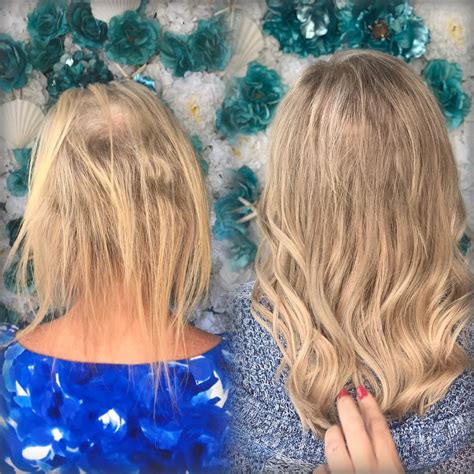Thin hair can be frustrating and limit your styling options. But with the advancements in hair extension technology, you can now achieve the voluminous, luscious locks you’ve always dreamed of.

10 Steps to Get Hair Extensions for Thin Hair
- Consult a professional: Before getting extensions, it’s crucial to consult an experienced hair stylist who specializes in hair extensions. They will assess your hair and recommend the best type and length of extensions.
- Choose the right type of extensions: There are various types of hair extensions, including clip-ins, tape-ins, and bonded extensions. Clip-ins are the easiest to apply and remove, while bonded extensions last the longest.
- Match your hair color: It’s important to choose extensions that closely match your natural hair color. Mismatched colors can be noticeable and make the extensions look unnatural.
- Consider the length and volume: The length and volume of the extensions you choose will depend on your personal preferences and the desired result. Longer and thicker extensions will create a more dramatic effect.
- Prepare your hair: Before applying the extensions, wash and thoroughly dry your hair. Make sure there are no tangles or knots.
- Apply the extensions: Follow the specific instructions for the type of extensions you are using. Clip-ins are simply clipped in, while tape-ins and bonded extensions require professional application.
- Blend the extensions: Once the extensions are applied, gently blend them with your natural hair using a brush or comb. This will help create a seamless appearance.
- Style your hair: You can now style your hair as usual. However, avoid using excessive heat styling, as this can damage the extensions.
- Maintain the extensions: Regular maintenance is essential to keep your hair extensions looking their best. Wash and condition your hair as needed, and use products specifically designed for hair extensions.
- Remove the extensions: The type of extensions you choose will determine how often they need to be removed. Clip-ins can be removed daily, while bonded extensions typically last several months.
Why Hair Extensions for Thin Hair Matter
- Increased volume and density: Hair extensions can instantly add thickness and volume to your hair, giving you a fuller and more luxurious look.
- Lengthening and styling versatility: With extensions, you can experiment with different lengths and styles without damaging your natural hair.
- Convenience and time-saving: Clip-in extensions are a convenient and quick way to change your look in minutes.
- Boost confidence: Thicker, fuller hair can significantly boost your confidence and self-esteem.
Benefits of Hair Extensions for Thin Hair
- Natural and seamless appearance: Modern hair extension methods create a seamless transition between your natural hair and the extensions, making them virtually undetectable.
- Minimal damage to natural hair: Clip-in extensions are non-damaging and can be applied and removed without any heat or chemicals.
- Long-lasting: Bonded extensions can last up to several months, providing you with a long-term solution for your hair concerns.
- Versatile styling options: Extensions allow you to experiment with different hairstyles, from voluminous blowouts to chic braids.
Pros and Cons of Hair Extensions for Thin Hair
Pros:
- Adds volume and fullness to thin hair
- Versatile styling options
- Boosts confidence
- Minimal damage
Cons:
- Can be expensive
- Regular maintenance required
- May not be suitable for all hair types
FAQs About Hair Extensions for Thin Hair
1. Will hair extensions damage my thin hair?
Not necessarily. Clip-in extensions are non-damaging, while bonded extensions can be applied and removed by a professional without causing significant damage.
2. How long do hair extensions last?
The longevity of hair extensions depends on the type you choose. Clip-ins can be used multiple times, while bonded extensions typically last several months.
3. Can I use hair extensions on short hair?
Yes, you can use hair extensions on short hair. However, the length of the extensions should be proportionate to the length of your natural hair to avoid an unnatural appearance.
4. How much do hair extensions cost?
The cost of hair extensions varies depending on the type, length, and quality of the extensions, as well as the salon you choose.
5. Can I dye or color hair extensions?
Most hair extensions can be dyed or colored, but it’s recommended to consult a professional to avoid damaging them.
6. How often should I wash my hair with extensions?
Wash your hair with extensions as often as needed, but avoid using harsh or clarifying shampoos, which can strip the extensions of their natural oils.
7. Can I swim or use hot tools with hair extensions?
Yes, you can swim and use hot tools with hair extensions. However, it’s important to take extra care to avoid damaging the extensions.
8. How do I remove hair extensions?
The removal method depends on the type of extensions you have. Clip-ins can be removed by simply unclipping them, while bonded extensions require professional removal.
